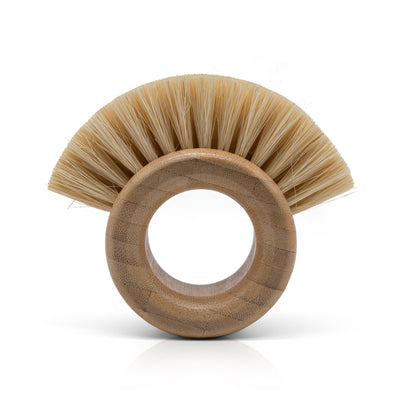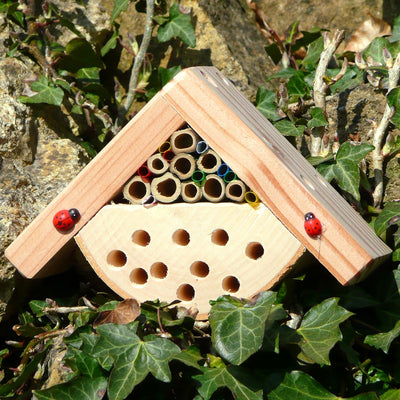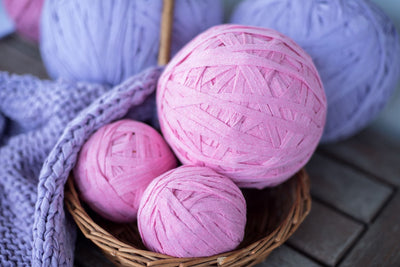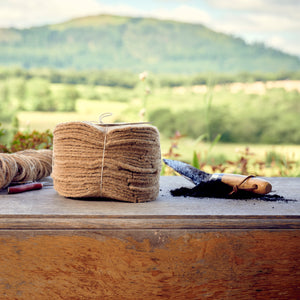These sheep wool pellets are a combination of wool and muck, pressed into pellet form. Sheep wool pellets have traditionally been used by organic gardeners as slug deterrents. They can put them off a bit but a study by the RHS found that wool pellets weren't all that successful. We find that the best and most brilliant use of these pellets is instead of water absorbent crystals. The commercial ones are made of polyacrylamide - read a bit more about it here if you're interested. I found one article that said they were benign and one that said they were carcinogenic. Anyway, these sheep wool pellets are completely natural, in fact use a waste product, and will absorb water, slowly releasing it back into the basket as the surrounding soil dries out. The wool pellets can hold 1.5 times their weight in water. They slowly biodegrade, releasing valuable nutrients into the soil.
You can also use them as a dense, nutrient rich mulch. Our felt shillies will go further but these will provide more nutrients and mulch combined if you really want to spoil your plants!
Just to be clear about how much is in a pack: the volume is 3.5 litres, and the weight is 2.0kg. They are weirdly dense for sheep wool.
What are the nutrients in the organic sheep wool pellets?
The contents are:
- Organic NK fertilizer 11-5
- total nitrogen: 11% N
- potassium oxide: 5% K20
- total sulphur: 2% S
- organic substance: 85%
As this is a natural product, the values given may vary slightly.
What can organic sheep wool pellets be used for?
100% untreated organic sheep's wool pellets provide long lasting mulch and soil improver. The pellets contain valuable nutrients that are slowly released to plants. They can absorb and store 1.5 times their own weight in water. This makes them perfect for hanging baskets, planters and window boxes.
The pellets can also be used as mulch to prevent weed competition, increase water retention in the soil, and protect delicate roots from temperature fluctuations.
Finally, the pellets have been shown to have some slug and snail repelling properties as they don’t like sliding over the prickly surface of the wool.
How good are sheep wool pellets at deterring slugs and snails?
You'll notice that we don't try to claim amazing slug deterring properties for our sheep wool pellets! Anecdotal evidence indicates that if there's a hosta with a border of pellets, and a hosta that's completely unprotected, the slugs will take the easy route. The coarse fibres in the wool are uncomfortable for them to slither over. But, think like a hungry slug. If there's nothing else to eat but a lush and delicious hosta, and there's a boundary that's a bit uncomfortable to climb over, if you're hungry enough you'll endure the discomfort and go for the hostas. I guess you worry about the return trip later when you're nice and full.
How can you stop slugs and snails from devouring your garden plants?
They are beasts. But, we've had some success with the Holeless Hosta recipe from RHS at Holehird. Make a decoction out of garlic and sprinkle this over the felt shillies, seems to work best.
There are various other options but my tried and tested is to go out with a torch at night and collect up bagfuls (up to you what you do with the bags of slugs) (but remember they are homing slugs if you're relocating them). Also, find plants they don't eat. And encourage the slug and snail eating wildlife in your garden, like hedgehogs and thrushes. Just please please whatever you do don't put poisonous slug pellets down. I won't post the video of the dying hedgehog writhing in agony after eating poisoned slugs, but trust me, it's traumatic.
How to encourage hedgehogs in the garden
Hedgehogs need all the help they can get, as they are becoming more scarce in the UK. They like wild untidy parts of the garden so keep some unkept sections if you can. They need somewhere to hibernate, and such a lot of cover dies back in the winter so it's a good idea to put out a hedgehog house for them. We put out a pile of straw in the autumn and it's fun to watch it disappear in a messy trail into the hedgehog house as Mrs Hog makes her hibernation nest perfect. They have a large range and will need the size of more than one garden to meet their ecological requirements. If your garden is fenced then you can create a little hedgehog sized gap so they can get through to your neighbours and increase the area they have access to.
These sheep wool pellets are a combination of wool and muck, pressed into pellet form. Sheep wool pellets have traditionally been used by organic gardeners as slug deterrents. They can put them off a bit but a study by the RHS found that wool pellets weren't all that successful. We find that the best and most brilliant use of these pellets is instead of water absorbent crystals. The commercial ones are made of polyacrylamide - read a bit more about it here if you're interested. I found one article that said they were benign and one that said they were carcinogenic. Anyway, these sheep wool pellets are completely natural, in fact use a waste product, and will absorb water, slowly releasing it back into the basket as the surrounding soil dries out. The wool pellets can hold 1.5 times their weight in water. They slowly biodegrade, releasing valuable nutrients into the soil.
You can also use them as a dense, nutrient rich mulch. Our felt shillies will go further but these will provide more nutrients and mulch combined if you really want to spoil your plants!
Just to be clear about how much is in a pack: the volume is 3.5 litres, and the weight is 2.0kg. They are weirdly dense for sheep wool.
What are the nutrients in the organic sheep wool pellets?
The contents are:
- Organic NK fertilizer 11-5
- total nitrogen: 11% N
- potassium oxide: 5% K20
- total sulphur: 2% S
- organic substance: 85%
As this is a natural product, the values given may vary slightly.
What can organic sheep wool pellets be used for?
100% untreated organic sheep's wool pellets provide long lasting mulch and soil improver. The pellets contain valuable nutrients that are slowly released to plants. They can absorb and store 1.5 times their own weight in water. This makes them perfect for hanging baskets, planters and window boxes.
The pellets can also be used as mulch to prevent weed competition, increase water retention in the soil, and protect delicate roots from temperature fluctuations.
Finally, the pellets have been shown to have some slug and snail repelling properties as they don’t like sliding over the prickly surface of the wool.
How good are sheep wool pellets at deterring slugs and snails?
You'll notice that we don't try to claim amazing slug deterring properties for our sheep wool pellets! Anecdotal evidence indicates that if there's a hosta with a border of pellets, and a hosta that's completely unprotected, the slugs will take the easy route. The coarse fibres in the wool are uncomfortable for them to slither over. But, think like a hungry slug. If there's nothing else to eat but a lush and delicious hosta, and there's a boundary that's a bit uncomfortable to climb over, if you're hungry enough you'll endure the discomfort and go for the hostas. I guess you worry about the return trip later when you're nice and full.
How can you stop slugs and snails from devouring your garden plants?
They are beasts. But, we've had some success with the Holeless Hosta recipe from RHS at Holehird. Make a decoction out of garlic and sprinkle this over the felt shillies, seems to work best.
There are various other options but my tried and tested is to go out with a torch at night and collect up bagfuls (up to you what you do with the bags of slugs) (but remember they are homing slugs if you're relocating them). Also, find plants they don't eat. And encourage the slug and snail eating wildlife in your garden, like hedgehogs and thrushes. Just please please whatever you do don't put poisonous slug pellets down. I won't post the video of the dying hedgehog writhing in agony after eating poisoned slugs, but trust me, it's traumatic.
How to encourage hedgehogs in the garden
Hedgehogs need all the help they can get, as they are becoming more scarce in the UK. They like wild untidy parts of the garden so keep some unkept sections if you can. They need somewhere to hibernate, and such a lot of cover dies back in the winter so it's a good idea to put out a hedgehog house for them. We put out a pile of straw in the autumn and it's fun to watch it disappear in a messy trail into the hedgehog house as Mrs Hog makes her hibernation nest perfect. They have a large range and will need the size of more than one garden to meet their ecological requirements. If your garden is fenced then you can create a little hedgehog sized gap so they can get through to your neighbours and increase the area they have access to.



































